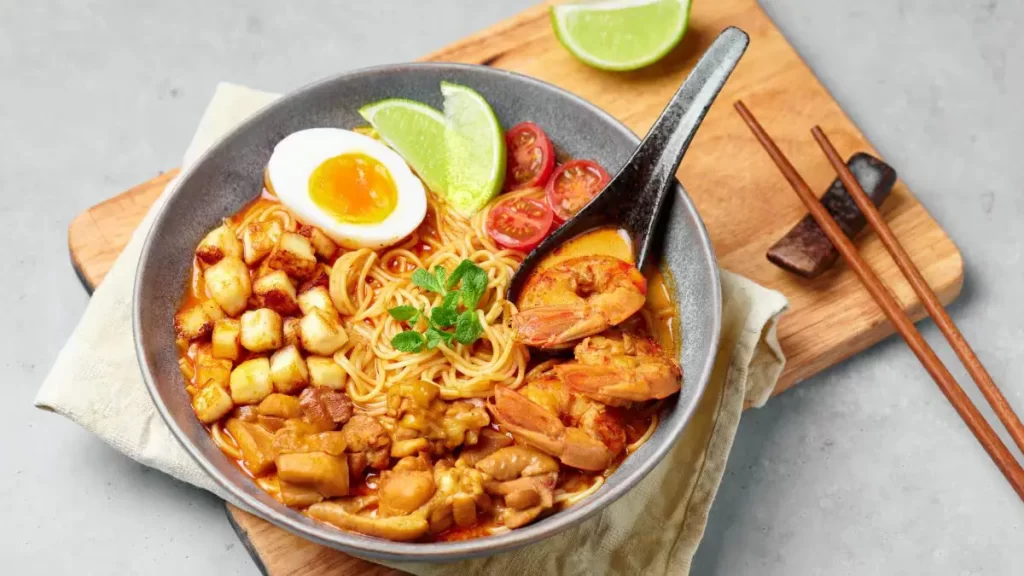Are you in dire need of a bowl of soul-soothing, tantalizing soup that sets your taste buds afire? Well, Laksa is the answer to your culinary prayers. Laksa, the ultimate bowl of Asian comfort food, is the spicy noodle soup of your dreams. This bowl full of bold flavors and beautifully poignant aromas has captured the hearts of people all around the world. It has humble beginnings as an ordinary dish in the streets of Southeast Asia and has since evolved to various regional interpretations.
Let the flavors of sweet, sour, salty, and spicy fill your mind as you take soup after soup. Whether you like a creamy coconut base, like laksa lemak, or a more tart and spicy filled assam laksa, each mouthful will leave you questioning why you haven’t eaten more soups. We’ll show you how to prepare it at home, as well as its origins and various regional variations. Say goodbye to zombie pallets and hello to Laksa!

Origins and History of Laksa
The adventure of laksa begins within the maritime Southeast Asia, a bright instance of the region’s wealthy cultural tapestry and culinary overhaul. Harleysville implies that laksa is amazing integration of Chinese and Malay cooking traditions. It had been growing within the trading ports of the area as half-Chinese, half-Malay kids, and cultural practices shaped its distinctive style, force per unit area 5.
At its format, laksa also was a straightforward dish, primarily containing vermicelli noodles, fish, and delightful broth. But, as the bowl traveled through the exhausting of different borders furthermore communities, it progressively absorbed the flavors and foods of every region it entered, emerge with the various and tasteful style that it’s these days. Today, it is not a noodle soup; it’s an emblem of Southeast Asia’s numerous culinary practices and therefore, the shared love of spirited, hearty meals.
Types of Laksa
Laksa’s diversity is one of its most exciting traits, with each region in Southeast Asia offering its unique twist on the dish. The most famous versions include Nyonya Laksa, Assam Laksa, and Curry Laksa, each with its distinct flavor profiles and ingredients.
Nyonya Laksa, also known as Laksa Lemak, is perhaps the most well-known variant outside of Asia. It features a coconut milk-based soup, enriched with spices like turmeric, galangal, and lemongrass, creating a rich, creamy broth that perfectly balances spice and sweetness.
Assam Laksa, on the other hand, is known for its tangy, sour broth made from tamarind, giving it a refreshing burst of flavor. This version typically includes mackerel fish, adding depth and umami to the dish.
Curry Laksa combines the creamy coconut milk of Nyonya Laksa with the aromatic spices of Indian curry, resulting in a hearty, spicy soup that’s both invigorating and comforting.
Ingredients Used in Laksa
The complexity and depth of flavor in laksa arise from its various components. Noodles, protein, and broth form the dish’s fundamental structure, but the components’ types and preparation methods can differ quite considerably. Noodles are frequently rice vermicelli; however, wheat noodles are also common.
The noodles offer a soft chewy texture that contrasts nicely with the spiciness of the soup. Proteins vary considerably across laksa variants, and prawn, chicken, tofu, and fish are common elements. Soup is where laksa comes alive, and its foundation includes coconut milk, fish stock, or tamarind juice with various aromatic herbs and spices such as lemongrass, galangal, and chili. When combined, these recipes yield a thick, flavorful, and wholly one-of-a-kind soup.

The Unique Flavor Profile of Laksa
Laksa’s appeal lies in its intricate balance of flavors. The interplay of sweet (from the coconut milk), sour (from tamarind or lime juice), salty (from fish sauce or shrimp paste), and spicy (from chilies) creates a harmonious taste that’s both complex and deeply satisfying.
This balance is not static but varies between different types of laksa, with some emphasizing the creamy sweetness of coconut milk, while others highlight the tangy zest of tamarind or the fiery kick of chili. It’s this diversity that makes laksa a fascinating dish, inviting diners to explore the breadth of Southeast Asian flavors.
Furthermore, the addition of aromatic herbs and spices not only enhances the flavor but also fills the dish with enticing, appetizing aromas, making the experience of eating laksa as much about the smell as it is about the taste.
Health Benefits of Laksa
Even though laksa is heavily creamy and spicy, it contains many nutritious elements that make it a healthy dish. Turmeric and galangal, flavoring ingredients in laksa, are botanicals with anti-inflammatory and antioxidant features. Lemongrass is also inserted into its paste, which is well-known for its digestion benefits.
Proteins from fish, chicken, or tofu include proper amino acids needed for muscle restoration and growth. If balanced with the amount of coconut milk and oil, laksa can be an integral part of your diet. Laksa is the ideal blend of health and happiness when enveloped with coconut oil, spices, and other elements and accompanied by a refreshing drink. Additionally, laksa can be modified to fit your dietary requirements.
How to Make Laksa at Home
Laksa is a delicious and heartwarming dish that is worth trying. Cooking this soup at home is an opportunity to experiment with Asian cuisine and improve your cooking skills. To cook laksa, you will need a paste, which includes shallots, garlic, lemongrass, galangal, turmeric, and chilies. To cook the paste, grind all the ingredients in a blender to a homogeneous mass. You should get a smooth mass, which is the basis of the jpslot login.
The paste should then be poured into a pot and fried until fragrant. Then the choice of broth for the paste is added — coconut milk for laksa lemak, fish broth for assam laksa, or a mixture of both for curry laksa. The soup should then be brought to a simmer. Then the protein, vegetables, which must be cooked until they are soft, are added. The soup is then poured over the cooked noodles and garnished with herbs and lime juice to taste. Sudanese chilies can also be used additionally to make it spicy. Cooking laksa at home will allow you to adjust its taste and make a dish to your liking.
Popular Variations and Regional Adaptations of Laksa
Laksa’s journey across Southeast Asia has resulted in a rich tapestry of variations, each reflecting the unique culinary heritage of its region. In Indonesia, you might find Laksa Bogor, characterized by its green broth made from ground green chili and aubergine. Singapore’s Katong Laksa features cut-up noodles, making it easier to eat with a spoon, a testament to the dish’s adaptability.
Malaysia’s Sarawak Laksa stands out for its distinctive broth made from sambal belacan, tamarind, and lemongrass, garnished with omelette strips and fresh coriander. Each variation not only offers a different taste experience but also tells the story of its people and place.
Exploring these variations provides a delicious journey through Southeast Asian culture and cuisine, highlighting the creativity and diversity of the region’s food traditions.
Best Places to Try Laksa Around the World
Even though laksa is a traditional Southeast Asian meal, it is so delicious that one can find it almost in any big city around the world. The best laksa could surely be tried at Singapore’s hot spot hawker centers, and the most authentic recipes would be offered. Meanwhile, visiting Penang, Malaysia, means that one should definitely try some assam laksa.
In Australia, the food community is influenced by Asian tastes and trends, so one can easily find a laksa bar that will offer a taste no worse than in its homeland. In general, no matter how far you are from the main continent, going to a local South East Asian or even just Asian place, one can definitely try out this lovely spicy soup.
Final Thoughts on Laksa
Laksa is more than just a noodle soup; it’s a culinary adventure that encapsulates the warmth, diversity, and vibrancy of Southeast Asian cuisine. With its rich flavors, varied textures, and comforting broth, it’s no wonder that laksa has become a beloved dish worldwide.
Whether you’re enjoying a creamy bowl of laksa lemak, tangy assam laksa, or the spicy kick of curry laksa, each spoonful promises a delightful experience that’s sure to leave you wanting more. So, dive into the world of laksa and discover the soul-warming comfort of this Asian noodle soup.
Also read: Experience the Excitement: Preakness 2024 – Thrills, Traditions, and Triumphs Unleashed




